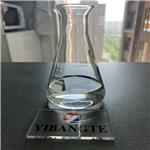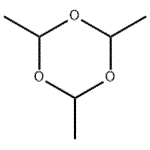- Paraldehyde
-

- $0.00 / 1kg
-
2023-10-31
- CAS:123-63-7
- Min. Order: 1kg
- Purity: 99%
- Supply Ability: 50000kg
- Paraldehyde
-

- $1.50 / 1g
-
2023-07-27
- CAS:123-63-7
- Min. Order: 1g
- Purity: 99.0% Min
- Supply Ability: 100 Tons
- Paraldehyde
-

- $4840.00 / 1T
-
2023-06-15
- CAS:123-63-7
- Min. Order: 1T
- Purity: 98%
- Supply Ability: 1-200mt
|
| | Paraldehyde Basic information |
| | Paraldehyde Chemical Properties |
| Melting point | 12 °C | | Boiling point | 65-82 °C | | density | 0.994 g/mL at 20 °C (lit.) | | vapor density | 1.52 (vs air) | | vapor pressure | 25.89 psi ( 55 °C) | | FEMA | 4010 | PARALDEHYDE | | refractive index | n20/D 1.39 | | Fp | 30 °F | | storage temp. | 2-8°C | | solubility | 120g/l | | pka | 16(at 25℃) | | form | solution | | Specific Gravity | 0.994 | | color | Colorless liquid | | Odor | disagreeable taste, aromatic odor | | explosive limit | 1.3-17.0%(V) | | Water Solubility | 125 g/L (25 ºC) | | Merck | 13,7098 | | BRN | 80142 | | Dielectric constant | 14.5(20℃) | | Stability: | Stable. Flammable. Incompatible with strong oxidizing agents, mineral acids. | | InChIKey | SQYNKIJPMDEDEG-UHFFFAOYSA-N | | LogP | 0.670 | | CAS DataBase Reference | 123-63-7(CAS DataBase Reference) | | NIST Chemistry Reference | Paraldehyde(123-63-7) | | EPA Substance Registry System | Paraldehyde (123-63-7) |
| | Paraldehyde Usage And Synthesis |
| Description | Paraldehyde was first synthesized in 1829 by Wildenbusch and
introduced into clinical practice in the United Kingdom by the
Italian physician Vincenzo Cervello in 1882. Paraldehyde,
a polymer of acetaldehyde, is a clear colorless or slightly yellow
transparent liquid with a strong aromatic as well as a disagreeable
taste that at low temperatures, it solidifies into a crystalline
mass. This agent decomposes with strong into toxic products
that may be released into water, soil, or atmosphere. | | Chemical Properties | Paraldehyde has a characteristic aromatic odor and warm, but disagreeable burning taste. | | Chemical Properties | Paraldehyde is a colourless to yellowish clear liquid. Pleasant, sweet odor. Less dense than water. Vapors are heavier than air. | | Uses | Paraldehyde is used in ethanol hangover prevention. It is also used in the treatment of rectal diseases in patients with delirium tremens. | | Uses | manufacture of organic compounds. | | Uses | Reactant involved in:• ;Modified Sanford reaction1• ;Synthesis of N-arylbenzoquinaldinium derivatives with antimicrobial activity2• ;Hydroformylation of alkenylamines3• ;Studies of molecules with inhibitory activity against HIV-1 integrase4• ;Irregular Wittig reactions for the formation of α-hydroxyketones5 | | Uses | Paraldehyde is used as solvent for fats, oils, waxes, rubber and resins; as substitute for acetaldehyde; as intermediate for organic chemicals, dyestuffs, accelerators for vulcanizations, rubber oxidants, etc. Product Data Sheet | | Preparation | Prepared by the polymerization of acetaldehyde catalyzed by hydrochloric acid and sulfuric acid at medium to high
temperatures. | | Definition | ChEBI: Paraldehyde is a trioxane that is 1,3,5-trioxane substituted by methyl groups at positions 2, 4 and 6. It has a role as a sedative. | | Brand name | Paral (Forest). | | Aroma threshold values | Recognition at 0.02 to 0.025 mg/m3 (air). | | General Description | Paraldehyde is recognizable as the cyclictrimer of acetaldehyde. It is a liquid with a strong characteristicodor detectable in the expired air and an unpleasanttaste. These properties limit its use almost exclusively toan institutional setting (e.g., in the treatment of deliriumtremens). In the past, when containers were opened and airadmitted and then reclosed and allowed to stand, fatalitiesoccurred because of oxidation of paraldehyde to glacialacetic acid. | | Air & Water Reactions | Highly flammable. Slightly soluble in water. Decomposed by light and air, on prolonged storage, to acetaldehyde and acetic acid. | | Reactivity Profile | Paraldehyde is an aldehyde. Paraldehyde is decomposed by light and air, on prolonged storage, to acetaldehyde and acetic acid. Incompatible with alkalis, hydrocyanic acid iodides and oxidizers. | | Health Hazard | INHALATION AND INGESTION: Irritation, headache, bronchitis, pulmonary edema. Irritating to digestive tract. Hypnotic and analgesic properties. Incoordination and drowsiness, followed by sleep. Larger doses-coma-weak pulse and shallow respiration, cyanosis-death from respiratory paralysis. EYES: irritation-can cause serious injury. SKIN: Dermatitis (skin inflammation). | | Safety Profile | A human poison by rectal route. Moderately toxic to humans by intramuscular route. Moderately toxic experimentally by inhalation, ingestion, intraperitoneal, and subcutaneous routes. Human systemic effects by rectal route: necrotic changes. A skin and severe eye irritant. Low doses produce hypnotic and analgesic effects. Larger doses depress the nervous system with loss of reflexes, coma, and respiratory depression leadmg to respiratory paralysis and death. Chronic effects include weight loss, muscular weakness, and mental fatigue. However, poisoning is rare. A hypnotic agent. Dangerous fire hazard when exposed to heat, flame, or oxidzers. Slight explosion hazard when exposed to heat or flame. Dangerous; keep away from heat and open flame. To fight fire, use alcohol foam, CO2, dry chemical. Potentially violent reaction with nitric acid. Incompatible with alkahes, hydrocyanic acid, iodides, oxidzers. When heated to decomposition it emits acrid smoke and irritating fumes. See also ALDEHYDES | | Synthesis | Paraldehyde, 2,4,6-trimethyl-1,3,5-trioxane (4.3.2), is a trimeric acetalde�hyde which is synthesized by the acid-catalyzed polymerization of acetaldehyde and at
moderate and high temperatures [32,33]. | | Potential Exposure | Paraldehyde is used primarily in medicine.
It is used as a hypnotic agent, in delirium tremens;
and in treatment of psychiatric states characterized by
excitement when drugs must be given over a long period of
time. It also is administered for intractable pain which does
not respond to opiates and for basal and obstetrical anesthesia.
It is effective against experimentally induced convulsions
and has been used in emergency therapy of tetanus,
eclampsia, status epilepticus; and poisoning by convulsant
drugs. Since it is used primarily in medicine, the chance of
accidental human exposure or environmental contamination
is low. However, paraldehyde decomposes to acetaldehyde
and acetic acid; these compounds have been found to be
toxic. In this case, occupational exposure or environmental
contamination is possible. Since paraldehyde is prepared
from acetaldehyde by polymerization in the presence
of an acid catalyst, there exists a potential for adverse
effects, although none have been reported in the available
literature. It is also used in the manufacture of organic
compounds. | | Environmental Fate | Paraldehyde is used in resin manufacture, as a preservative, and
in other processes as a solvent. Paraldehyde may enter to the
environment via industrial effluents or hospital wastes. Acetaldehyde
and acetic acid are two products of degradation of
paraldehyde. This compound and its degradation products
may be released into water, soil, or atmosphere and then they
may be removed from the atmosphere by precipitation. | | Shipping | UN1264 Paraldehyde, Hazard Class: 3; Labels:
3-Flammable liquid. | | Purification Methods | Wash paraldehyde with water and fractionally distil it. Alternatively, it is purified by drying with anhydrous Na2SO4, then cooled to 5o, and the frozen material is separated by decantation. The solid is distilled (b 121-124o/atm), the distillate is collected, stored over anhydrous Na2SO4 for several days and re-distilled at atmospheric pressure before use [Le Fevre et al. J Chem Soc 290 1950]. The 2r,4c,6t-trimethyl-1,3,5-trioxane has m 14.5o, b 125o/760mm. [Beilstein 19 II 394, 19 III/IV 4715. 19/9 V 112.] | | Incompatibilities | Vapor or liquid may form explosive
mixture with air. Incompatible with strong oxidants, strong
acids; alkalis, ammonia, amines, iodides, hydrocyanic acid.
Violent reaction with liquid oxygen. Contact with acids
form acetaldehyde. Attacks rubber and plastics. | | Waste Disposal | Incineration in added solvent.
Consult with environmental regulatory agencies for guidance
on acceptable disposal practices. Generators of waste
containing this contaminant (≥100 kg/mo) must conform
with EPA regulations governing storage, transportation,
treatment, and waste disposal. |
| | Paraldehyde Preparation Products And Raw materials |
|